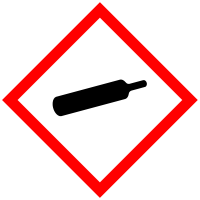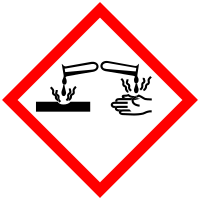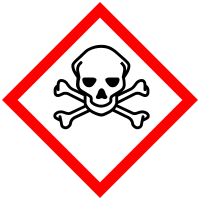
Improving Member States preparedness to face an HNS pollution of the Marine System (HNS-MS)
Hydrochloric Acid Solutions (20%)
Description Top
| CAS number | 7647-01-0 |
| UN number | 1789 |
| Chemical formula | HCl |
| Standard European Behaviour Classification (SEBC) | Dissolver that evaporates (DE) |
| Abilities | Solution. |
GESAMP Hazard profile
| A1 | A2 | B1 | B2 | C1 | C2 | C3 | D1 | D2 | D3 | E1 | E2 | E3 |
| 0 | NI | 1 | NI | 1 | 1 | 3 | 3C | 3 | NI | DE | 3 |
Marine pollution Classification (MARPOL Annex II)
| Category | Description |
| Z | Noxious Liquid Substances which, if discharged into the sea from tank cleaning or deballasting operations, are deemed to present a minor hazard to either marine resources or human health and therefore justify less stringent restrictions on the quality and quantity of the discharge into the marine environment. |
Alternate names for this chemical
Hydrochloric Acid Solutions (20%)
Solutions D'Acide Chlorhydrique (20%)
Solutions D'Acide Chlorhydrique (20%)
Physico-chemical properties Top
| Chemical formula | HCl | |
| Molar mass | 36.458 [g/mol] | |
| State | Liquid at 25°C and 1 atm | |
| Fusion temperature | -62.25 [°C] | |
| Boiling temperature | 108.6 [°C] | |
| Density |
|
|
| Kinematic viscosity |
|
|
| Hydrosolubility |
|
|
| Vapour pressure |
|
Behaviour Top
| Standard European Behaviour Classification (SEBC) | Dissolver that evaporates (DE) |
Hazards Top



Danger
Hazards statements
Health
H314
Causes severe skin burns and eye damage.
H331
Toxic if inhaled.
Precautionary statements
General
P101
If medical advice is needed, have product container or label at hand.
Prevention
P261
Avoid breathing dust/fume/gas/mist/vapours/spray.
P280
Wear protective gloves/protective clothing/eye protection/face protection.
Response
P314
Get medical advice/attention if you feel unwell.
P305 + P351 + P338
IF IN EYES: Rinse cautiously with water for several minutes. Remove contact lenses, if present and easy to do. Continue rinsing.
Storage
P405
Store locked up.
P403 + P233
Store in a well-ventilated place. Keep container tightly closed.
GESAMP Top
GESAMP Hazard profile
| A1 | A2 | B1 | B2 | C1 | C2 | C3 | D1 | D2 | D3 | E1 | E2 | E3 |
| 0 | NI | 1 | NI | 1 | 1 | 3 | 3C | 3 | NI | DE | 3 |
A1: Bioaccumulation
| Rating | Description |
| 0 | No potential to bioaccumulate |
A1a:
| Rating | Description |
| Inorg |
A1b:
| Rating | Description | Criteria |
| 0 | No potential to bioaccumulate | No measurable bioconcentration factor (BCF) |
A2: Biodegradation
| Rating | Description |
| NI | No Information |
B1: Acute aquatic toxicity
| Rating | Description | Criteria [mg/l] |
| 1 | Practically non-toxic | 100 < LC/EC/IC50 ≤ 1000 |
B2: Chronic aquatic toxicity
| Rating | Description |
| NI | No Information |
C1: Acute oral toxicity
| Rating | Description | Criteria [mg/Kg] |
| 1 | Slight | 300 < AOTE ≤ 2000 |
C2: Acute dermal toxicity (skin contact)
| Rating | Description | Criteria [mg/Kg] |
| 1 | Slight | 1000 < ADTE ≤ 2000 |
C3: Acute inhalation toxicity
| Rating | Description | Criteria [mg/l] (4 hours exposure) |
| 3 | Moderately high | 0.5 < AITE ≤ 2 |
D1: Skin irritation or corrosion
| Rating | Description | Sign | GHS category |
| 3C | Corrosive | Full-thickness skin ne | Corrosive Category 1A |
D2: Eye irritation
| Rating | Description | Sign | GHS category |
| 3 | Severely irritating or corrosive | Severe conjunctoblepha | Irritant Category 1 |
D3: Long-term health effects
| Notation | Hazard endpoint | Description | GHS category |
| No Information |
E1: Tainting of seafood
| Rating | Description |
| NI | No Information |
E2: Behaviour of chemicals in the marine environment
| Rating | Description |
| DE | Dissolver that evaporates |
E3: Interference with the use of coastal amenities
| Rating | Interference | Description | Interpretation | Warning |
| 3 | Highly objectionable | 1 is highly acutely toxic; and/or 2 is severely irritant or corrosive to skin or eyes; and/or 3 is carcinogenic, mutagenic or reprotoxic; and/or 4 is a floater or persistent floater with associated health effects | 1 C1 and/or C2 and/or C3 = 4; and/or 2 D1 or D2 = 3, 3A, 3B, or 3C; and/or 3 D3 contains C, M or R; and/or 4 E2 = F or Fp and D3 contains Ss, Sr, T, A, N, or I | Warning issued leading to the closure of amenities |
GHS Security Information



Danger
About the project
HNS-MS is a decision-support tool that Belgian and French maritime authorities as well as coastguard stations can activate in order to forecast the drift, fate and behavior of acute marine pollution by Harmful Noxious Substances (HNS) accidentally released in the marine system.
Contact us
Copyright © 2015–2026 HNS-MS Consortium
 HNS-MS has been funded by DG-ECHO under agreement ECHO/SUB/2014/693705 and runs from 1 January 2015 to 31 March 2017.
HNS-MS has been funded by DG-ECHO under agreement ECHO/SUB/2014/693705 and runs from 1 January 2015 to 31 March 2017.